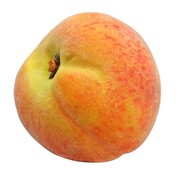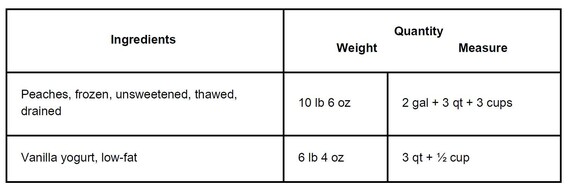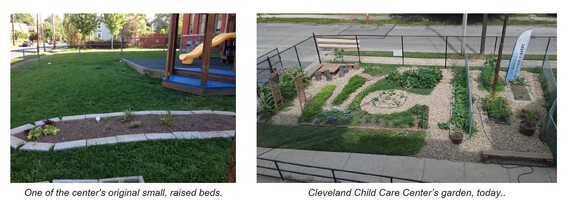Featured Food: Peach

Peaches are a sweet and juicy fruit that boasts a variety of vitamins and minerals. Vitamin A, Vitamin C, and Potassium are key nutrients found in peaches. Vitamin A is essential to the health of our eyes and our vision. Vitamin C strengthens the immune system and fights against illness. Potassium is a mineral that is used in our bodies in a variety of ways and has been linked to heart health.
Peaches are a type of stone fruit. Stone fruits, or drupes, have soft flesh and arecharacterized by a hard pit in the center. Peaches are to have likely originated inChina but have grown in the United States since their arrival in the 17th century.Today, warmer weather states like Georgia and California produce much of thecountry’s peach crop, but peaches are also grown here in Ohio too.
|
Featured Recipe: Peach and Yogurt Smoothies
 Makes 25 servings.
Instructions:
- Wash hands with soap and water for at least 20 seconds.
- Combine peaches and yogurt in a blender. Mix until smooth.
- Serve 1 ¼ cups (10 oz ladle). Serve immediately or keep cold at 40 ̊F or lower.
Child and Adult Care Food Program (CACFP) Crediting Information:
¾ cup fruit, 1 oz eq meat alternate
Notes:
- This recipe contains milk.
- Refrigerating smoothies for more than 3 hours may cause texture change.
- Smoothies can be made in advance and stored in the freezer.
- For CACFP crediting, yogurt must not contain more than 23 grams of totalsugars per 6 ounces.
- This recipe can be doubled to yield 50 servings. See details online by clicking the
link.
Meals to Try
Easy Grilled Peaches
Peach Salsa
Peach Glazed Pork Tenderloin
|
|
 |
Featured Activities
The United States Department of Agriculture developed garden-based nutrition education for children ages 3 through 5 years old in family daycare settings. Through the activities in this curriculum, children can touch, smell, feel, and taste new fruits and vegetables. The
Grow It, Try It, Like It! Peach Tree Orchard curriculum provides a variety of activities centered around peaches.
Use Feed Our Future Peaches Word Search to keep kids entertained at summer meal sites.
National Agriculture in the Classroom is an organization that supports state programs by providing a network to improve agricultural literacy among PreK-12teachers and students. A variety of resources are available for teachers and students alike. Utah Agriculture in the Classroom developed a peach-specific lesson plan titled, "Peaches: What's All the Fuzz About?"
Featured Resources
OSU Extension Farm to Early Care and Education
The Ohio State University Extension Farm to School team developed a series of training videos for Early Child Care and Education Centers. These training videos are available on YouTube in the Ohio State Farm to ECE playlist for viewing. Learn how to start a garden, teach kids about composting, cook in the classroom and wash local produce at your childcare center.
KidsGardening
Kids Gardening is a non-profit organization dedicated to creating opportunities for kids to learn and play through gardening. A variety of grant opportunities and educational resources, including activities and lesson plans are available for review. Guides on starting a school, early childhood education program, or community garden are also available.
Featured Sponsor
Cleveland Child Care and Early Learning Center
Cleveland Child Care and Early Learning Center, a sponsor of the CACFP, has been involved in Farm to Summer activities since 2014. Center director Ragelle Gigante says a partnership with the OSU Extension and their Summer Sprout program was integral to the inception of the center’s garden. OSU Extension offers many resources such as their “Dig In” class and access to Master Gardeners and other gardeners in the local area. She also utilized OSU Extension’s gardening hotline and free seeds and seedlings when starting. What began as 3 small raised beds in 2014 has grown into a 40 feet by 20 feet interactive garden with winding pathways, trellises, and a variety of fruits, vegetables, and flowers.
Cleveland Child Care has expanded what they grow to tomatoes, cucumbers, eggplant, berries, peppers, corn, carrots and more. They have made sure to include sunflowers as companion plants to feed pollinators and attract birds toward off garden pests. Ragelle says, “The children love to be hands-on in the garden. They love to investigate and see what items are ready to be picked and harvested. They really enjoy watching the progress of the vegetables growing, but when they see that they are ready to be picked, they almost fight over who gets to pick it. We must help them by taking turns so that everyone gets a chance to harvest. Their favorite things to harvest are the zucchini and corn.” Once harvested, the cook at Cleveland Child Care will incorporate the produce in to lunch the following day or the children with get to take their bounties home with them to share with their families.
The garden activities are also incorporated into classroom learning. Center teachers use the garden and the produce grown in their curriculum to perform taste tests, science, and art projects. The garden is also a way to engage families and families are encouraged to visit the gardens with their kids to harvest produce.
Ragelle advises sponsors new to gardening to “Start small…so that it doesn't become overwhelming with a big garden right off the bat. We used cinder blocks(four our raised beds) because we felt it was less maintenance in the long run. Wood often deteriorates over time. Keep it simple and stick to some of the veggies that are lower maintenance.”

|